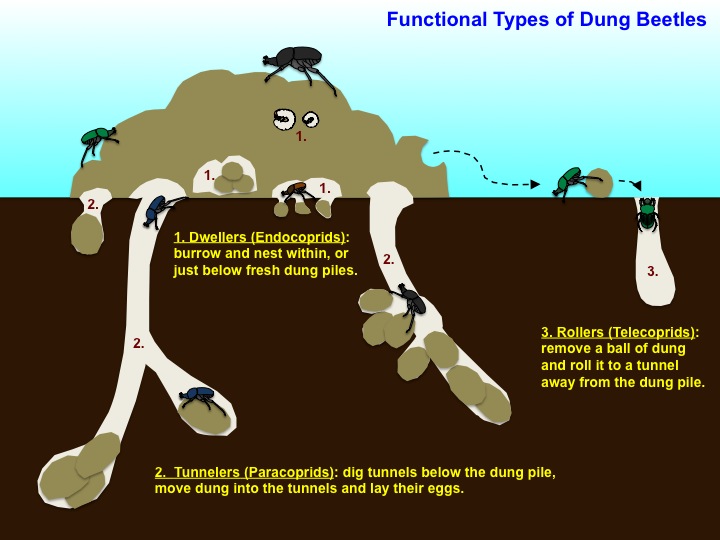Class Insecta, Order Coleoptera, Family Scarabaeidae
Size: Adults vary in size from ⅛ (0.3 cm) to 1 ¼ inches (4 cm) long depending on the species.
Metamophosis: Complete (Holometabolism).
Adults: Most dung beetles are dark in color, brown to black, and many are shiny. Some are more brightly colored such as Phanaeus vindex, which is a metallic green color. Some males have a horn.
Larvae: Most are cream colored, C-shaped, with brownish legs and head. They complete their life inside of dung.
Life Cycle: Adults are attracted to fresh dung. Some make balls out of it, roll it to a tunnel and bury it. Others bury balls of dung beneath the pile. Some species do not make dung balls, rather the larvae develop in the dung pile. Eggs are laid in the dung and the larvae feed and develop within it. When larval development is complete, they pupate within the dung. Adults emerge and start looking for fresh dung. Illustration of dung beetle life cycle.
Good Things They Do:
1. By digging tunnels and burying dung, dung beetles improve nutrient recycling and soil quality.
2. Because dung beetles eat dung, they remove food for flies…which means fewer flies.
Interesting Facts:
Dung beetles are very strong, one species is able to pull 1,141 times its own body weight. That is the equivalent of a 150-pound person moving a pile of six school buses.
About living in poop...some different approaches by dung beetles:
There are 3 different types of dung beetles. Those that:
1. Burrow, lay eggs and feed within, or just below fresh dung piles…these are called dwellers (Endocoprids).
2. Dig tunnels below the dung pile, the move dung into the tunnels and lay their eggs. These beetles are tunnelers (Paracoprids).
3. Remove a ball of dung and roll it to a tunnel away from the dung pile. These beetles are called rollers (Telecoprids).
